
Introduction to Organizational Structure of Project Management
Organizational structure refers to the way a company or organization is setup. It is usually defined using a hierarchy chart that shows how groups or functions report within the organization.
For Project Managers, a company's organizational structure type will affect how resources are allocated to the project and will be a factor in how much influence the Project Manager will have within the organization.
Three Types of Project Management Structures:
An organizational structure could be described as the official line of authority and control within an organization. Project management structures tell us how reporting relationships work in a particular organization.
Depending on the environment the organization finds itself operating in, the goals they set for themselves and the nature of work being done, you would find that organizations are structured in 3 ways:
Now that we know how organizational structures are categorized, let’s take a closer look at each one of them to see what makes them unique.
1. Functional Organizational Structure
In a functional organizational structure, you would find the components of a hierarchy system where authority-driven decisions on budget, schedule, and equipment rest on the shoulders of the functional manager who possesses a significant level of expertise in the same field.
That is to say that the project manager, in this type of organization has little to no authority here; in some functional organizations, that position does not even exist.
What would you find, however, is that the work is broken down into departments such as the human resource department, sales department, finance, public relations, administration, etc.
In simple terms, it can be likened to that of a more traditional company where staff is presided over by a supervisor, based on their functions within the organization and communication is most often done through the department heads to senior management.
What is fascinating about this type of organizational structure is that employees appear to be more skilled in their respective departments, thereby leading to greater work efficiency. Everyone knows who to hold accountable if something were to go wrong as responsibilities are predetermined.
On the downside, the work may prove monotonous over time, which could result in less enthusiasm and reduced loyalty to the organization. In addition to that, you would also find that cross-departmental communication becomes poor and the high level of bureaucracy could affect decision-making negatively.
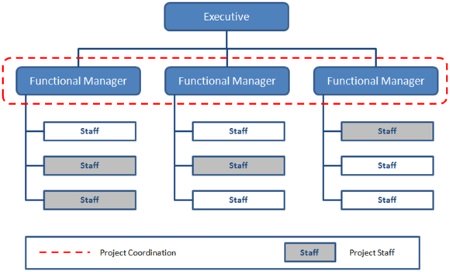
Examples of functions within a company are:
In a functional organization, every employee is positioned within only one function and has one manager they report to, the Functional Manager. The Functional Manager assigns and manages the employees work and handles administrative tasks such as employee compensation.
2. Project Based Organizational Structure
The projectized organizational structure is the complete opposite of the functional organizational structure even though the organization may still group staff according to their work functions.
In this case, the project management team structure is organized in such a way that the project manager has project authority. He has jurisdiction over the project’s budget, schedule, and the project team. You would find him at the top of the hierarchical structure, calling all the shots; with employees playing supporting roles for the project. At the end of the project, the project team members are released and resources directed towards more relevant areas.
What’s great about this kind of structure is that there is a clear, established line of authority; resulting in faster decision-making and approval. Communication becomes easier and more effective and project team members gain more experience working on different types of projects as the need for them arises.
A major disadvantage to this type of organizational structure, however, would be that employees could see themselves being under a lot of pressure most of the time, especially if they happen to work on multiple projects at the same time. This often leads to poor communication amongst the team members as everyone is left more or less playing “catch-up”.
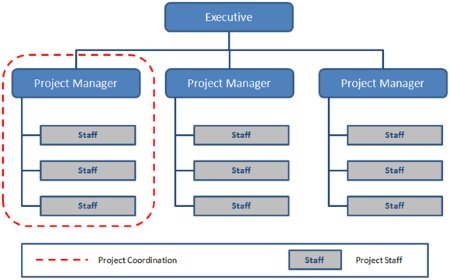
Matrix Organizational Structure
Matrix organizations blend features of project-based and functional organizational structures.
The key challenge with a matrix organization is that every employee has two (or more) managers they report to, their Functional Manager and the Project Manager. If they are working on multiple projects, they may have even more managers to report to.
There are three types of matrix organizations:
The matrix organizational structure can be found lying somewhere between the functional organizational structure and the projectized organizational structure depending on what type of matrix structure is being run.
For instance, the strong matrix organizational structure has some similarities with that of a projectized organizational structure in the sense that the project manager is responsible for a project. If the organization is running a weak matrix structure, then the project authority would fall to the hands of a functional manager – as it is in a functional organization. Interestingly enough, in a balanced matrix organization, both the project manager and the functional manager shares equal authority for the project.
If an organization finds itself working in a dynamic environment, then this might be the right structure to run with it and it promotes greater efficiency, helping the organization respond to customer demands or changes in the marketplace, faster.
This is easily achieved because while the project manager exhibits project authority in a horizontal manner, the functional manager does so in a vertical, flowing downwards. For example, the project manager could be responsible for handling project schedule or budget while the functional manager would be responsible for outlining and distributing responsibilities, overseeing the performance of the equipment, etc.
Weak Matrix:
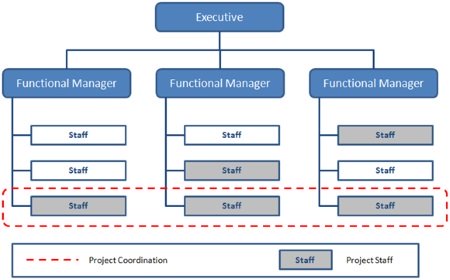
A weak matrix organizational structure maintains many of the features of the functional organizational structure. The role of the Project Manager is more that of a Project Coordinator. Their ability to make or enforce decisions is low and most of the authority remains with the Functional Manager.
Balance Matrix:
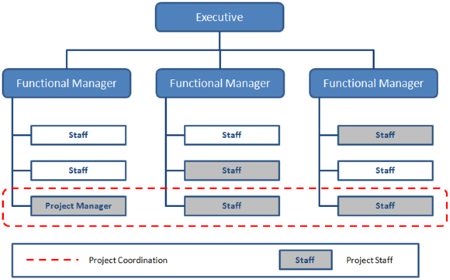
A balanced matrix organizational structure recognizes the need for a Project Manager. However, the Project Manager does not have full authority over the project, project staff or project budget.
Strong Matrix:
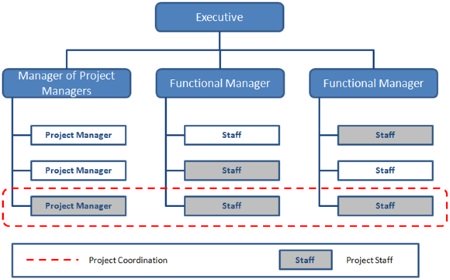
A strong matrix organizational structure has many of the features of the projectized organizational structure. They have full-time Project Managers and project administrative staff. Project Managers have considerable authority over the project in this organzational structure.
How Organizational Structure Influences Project Management:
Two of the key project aspects affected by organizational structure types are Project Manager Authority and Resource Availability.
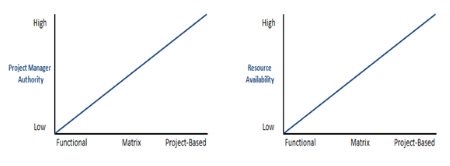
As you move across the spectrum from Functional to Matrix to Project-Based organizational structure types, the organization will move from favoring ongoing operations to favoring projects.
On the left side of the spectrum are Functional Organizational Structures. As a Project Manager, you will have limited positional authority in these type of organizations. You will need to rely on expert authority and referent authority to get project tasks completed. Because of this, you will need to develop your influencing and negotiating skills if you want to be successful.
From a Resource Availability perspective, you will be dependent on the Functional Managers in your organization to provide you with resources. In these cases, the project resources will report indirectly to you.
On the right side of the spectrum are Project-Based Organizations. As a Project Manager, you will have more positional authority the further right your project sits on the spectrum. This doesn't mean you can just command others, but you will have more formal authority for getting project tasks completed.
From a Resource Availability perspective, you will also have greater control over your project resources since they will be more likely to directly report to you and not to a functional manager.
Understanding what type of organizational structure is used by your company will help you determine how you should manage your project.
To Passing the PMP Certification Exam - Understanding the Organization Structure is Important.
Resource: PMBOK 6, Project-Management-skills, ITechGurus